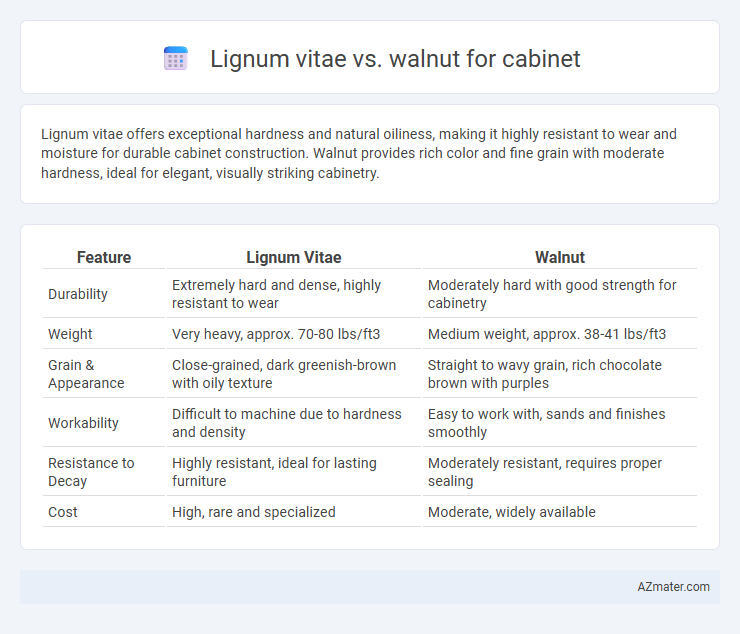Lignum vitae offers exceptional hardness and natural oiliness, making it highly resistant to wear and moisture for durable cabinet construction. Walnut provides rich color and fine grain with moderate hardness, ideal for elegant, visually striking cabinetry.
Table of Comparison
| Feature | Lignum Vitae | Walnut |
|---|---|---|
| Durability | Extremely hard and dense, highly resistant to wear | Moderately hard with good strength for cabinetry |
| Weight | Very heavy, approx. 70-80 lbs/ft3 | Medium weight, approx. 38-41 lbs/ft3 |
| Grain & Appearance | Close-grained, dark greenish-brown with oily texture | Straight to wavy grain, rich chocolate brown with purples |
| Workability | Difficult to machine due to hardness and density | Easy to work with, sands and finishes smoothly |
| Resistance to Decay | Highly resistant, ideal for lasting furniture | Moderately resistant, requires proper sealing |
| Cost | High, rare and specialized | Moderate, widely available |
Overview: Lignum Vitae vs Walnut in Cabinetry
Lignum Vitae, known for its exceptional density and natural oils, offers unmatched durability and resistance to moisture, making it ideal for high-wear cabinetry. Walnut, prized for its rich, dark tones and smooth grain, provides aesthetic elegance with moderate hardness suitable for decorative and functional cabinets. Choosing between Lignum Vitae and Walnut hinges on prioritizing either heavy-duty durability or refined visual appeal in cabinet construction.
Appearance and Grain Patterns Comparison
Lignum vitae exhibits a rich, dark greenish-brown hue with subtle streaks, offering a unique, dense appearance ideal for luxurious cabinetry. Walnut showcases a warm, chocolate-brown base with varied grain patterns ranging from straight to wavy, creating dynamic visual interest. The smooth, interlocked grain of lignum vitae contrasts with walnut's more pronounced and varied grain texture, influencing the final aesthetic of cabinet surfaces.
Hardness and Durability: Which Wood Prevails?
Lignum vitae, with a Janka hardness rating of approximately 4,390 lbf, surpasses walnut, which ranks around 1,010 lbf, making lignum vitae significantly harder and more resistant to dents and scratches. In terms of durability, lignum vitae's natural oils and dense grain structure offer superior resistance to moisture, decay, and wear, ideal for high-traffic cabinets. Walnut, while easier to work with and prized for its rich color and grain, may require more maintenance to maintain structural integrity in demanding environments.
Workability: Ease of Shaping and Finishing
Lignum vitae exhibits exceptional workability with its dense, self-lubricating fibers that allow smooth shaping and fine, polished finishes, though it requires sharp tools due to its hardness. Walnut is renowned for its ease of shaping and finishing, offering a balanced hardness that sands and stains uniformly, making it ideal for intricate cabinet designs. Both woods deliver excellent finishing results, but walnut offers a more straightforward experience for hand tools and detailed woodworking.
Resistance to Moisture and Decay
Lignum vitae is highly prized for its exceptional resistance to moisture and natural decay due to its dense, oily composition, making it ideal for humid or outdoor environments where wood longevity is critical. Walnut, while visually appealing and moderately resistant to decay, lacks the natural oils that provide lignum vitae with superior protection against water absorption and fungal damage. For cabinet applications requiring durability in moist conditions, lignum vitae significantly outperforms walnut in maintaining structural integrity and resisting rot.
Color Variations and Aging Effects
Lignum vitae displays rich greenish-brown tones that deepen to a darker, almost black hue with age, offering a dramatic and exotic appearance for cabinets. Walnut features warm chocolate brown shades with purple and gray undertones that mellow into a soft, silky patina over time, enhancing its classic appeal. Both woods exhibit distinct aging effects, with Lignum vitae becoming denser and more lustrous, while Walnut develops a graceful, subtle darkening that enriches its natural grain.
Environmental Impact and Sustainability
Lignum vitae is a dense, slow-growing hardwood known for its natural oils, making it highly resistant to decay and reducing the need for chemical treatments, which benefits environmental sustainability. Walnut, a faster-growing species commonly sourced from managed forests, offers better carbon sequestration rates and is often available through certified sustainable forestry programs like FSC. Choosing walnut typically results in a lower environmental footprint due to its quicker renewability and more widespread sustainable harvesting practices compared to the rare and endangered Lignum vitae.
Availability and Cost Considerations
Lignum vitae, known for its exceptional density and natural oils, is significantly rarer and more expensive than walnut, which is widely available and cost-effective for cabinetry. Walnut offers a versatile range of grades and finishes, providing affordable options for custom and mass-produced cabinets. Lignum vitae's limited availability and higher price point typically restrict its use to specialty or luxury woodworking projects.
Common Uses and Applications in Cabinets
Lignum vitae is prized for its exceptional hardness and natural oils, making it ideal for high-wear cabinet components like hinges, drawer slides, and structural supports in luxury cabinetry. Walnut offers rich color and fine grain, commonly used for cabinet faces, doors, and decorative veneers, providing both strength and aesthetic appeal. Both woods serve distinct purposes: lignum vitae enhances durability in functional parts, while walnut focuses on visual elegance and surface finish in cabinetry.
Choosing the Right Wood: Lignum Vitae or Walnut?
Lignum vitae offers exceptional hardness, natural oils for water resistance, and superior durability, making it ideal for high-wear cabinets requiring longevity and robustness. Walnut features a rich, dark grain with smooth workability and moderate hardness, providing aesthetic appeal and ease of finishing for decorative or luxury cabinetry. Selecting between Lignum vitae and walnut depends on the balance of durability needs versus visual elegance and ease of crafting in cabinet construction.

Infographic: Lignum vitae vs Walnut for Cabinet
 azmater.com
azmater.com